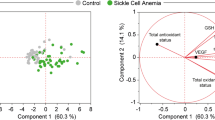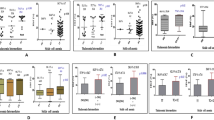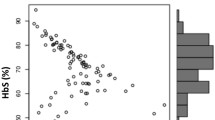Abstract
Hydroxyurea (HU) was approved to be used in the treatment of sickle cell disease (SCD) because of its anti-sickling potential. However, there is variability in HU response among SCD patients and this can be due to physiological, socioeconomic, environmental, metabolic and/or genetic factors. The present review focuses on the latter two. Three quantitative trait loci, HBG2, BCL11A and HMIP, have been suggested as important markers for HU response. Other genes (ASS1, KLF10, HAO2, MAP3K5, PDE7B, TOX, NOS1, NOS2A, FLT1, ARG1, ARG2, UGT1A1, OR51B5/6, SIN3A, SALL2, SAR1A, UTB, OCTN1, CYP2C9, AQP9, MPO, CYP2E1, and GSTT1) have also been considered. Studies implicate catalase, urease, horseradish peroxidase and enzymes of CYP450 family in HU metabolism. However, little is known about these enzymes. Therefore, further studies are needed to elucidate the metabolic pathway of HU, which will facilitate pharmacogenomic studies and help in identification of candidate genes for predicting HU response.
This is a preview of subscription content, access via your institution
Access options
Subscribe to this journal
Receive 6 print issues and online access
$259.00 per year
only $43.17 per issue
Buy this article
- Purchase on Springer Link
- Instant access to full article PDF
Prices may be subject to local taxes which are calculated during checkout




Similar content being viewed by others
References
Villani P, Maserati R, Regazzi MB, Giacchino R, Lori F. Pharmacokinetics of hydroxyurea in patients infected with human immunodeficiency virus type I. J Clin Pharmacol. 1996;36:117–21.
Opacic N, Zorc B, Cetina M, Mrvos-Sermek D, Raic-Malic S, Mintas M. Synthesis and X-ray crystal structure study of the hydroxyurea and hydantoin derivatives of l-valine. J Pept Res. 2005;66:85–93.
Dalton RN, Turner C, Dick M, Height SE, Awogbade M, Inusa B, et al. The measurement of urinary hydroxyurea in sickle cell anaemia. Br J Haematol. 2005;130:138–44.
Latagliata R, Spadea A, Cedrone M, Di Giandomenico J, De Muro M, Villivà N, et al. Gruppo Laziale SMPC Ph1 neg. Symptomatic mucocutaneous toxicity of hydroxyurea in Philadelphia chromosome-negative myeloproliferative neoplasms: the Mister Hyde face of a safe drug. Cancer . 2012;118:404–9.
Lori F, Lisziewicz J. Rationale for the use of hydroxyurea as an anti-human immunodeficiency virus drug. Clin Infect Dis. 2000;30:S193–7.
Sassi H, Bachir D, Habibi A, Astier A, Galactéros F, Hulin A. No effect of CYP450 and P-glycoprotein on hydroxyurea in vitro metabolism. Fundam Clin Pharmacol. 2010;24:83–90.
Lori F, Malykh A, Cara A, Sun D, Weinstein JN, Lisziewicz J, et al. Hydroxyurea as an inhibitor of human immuunodeficiency virus type 1 replication. Sci New Ser. 1994;266:801–5.
Restituto P, Mugueta C, Alegre E, Monreal JI, Varo N. Analytical interference of hydroxyurea in the determination of urea, uric acid, and lactic acid. Anal Biochem. 2006;357:147–9.
King SB. The nitric oxide producing reactions of hydroxyurea. Curr Med Chem. 2003;10:437–52.
Huang J, Yakubu M, Kim-Shapiro DB, King SB. Rat liver-mediated metabolism of hydroxyurea to nitric oxide. Free Radic Biol Med. 2006;40:1675–81.
Kolliopoulou A, Stratopoulos A, Siamoglou S, Sgourou A, Ali BR, Papachatzopoulou A, et al. Key pharmacogenomic considerations for sickle cell disease patients. OMICS J Integr Biol. 2017;21:314–22.
Rees DC, Williams TN, Gladwin MT. Sickle-cell disease. Lancet. 2010;376:2018–31.
Silva-Pinto AC, Angulo IL, Brunetta DM, Neves FIR, Bassi SC, Santis GCD, et al. Clinical and hematological effects of hydroxyurea therapy in sickle cell patients: a single-center experience in Brazil. Sao Paulo Med J. 2013;131:238–43.
Ma Q, Wyszynski DF, Farrell JJ, Kutlar A, Farrer LA, Baldwin CT, et al. Fetal hemoglobin in sickle cell anemia: genetic determinants of response to hydroxyurea. Pharm J. 2007;7:386–94.
Gravia A, Chondrou V, Sgourou A, Papantoni I, Borg J, Katsila T, et al. Individualizing fetal hemoglobin augmenting therapy for β-type hemoglobinopathies patients. Pharmacogenomics. 2014;15:1355–64.
Andrae U. Evidence for the involvment of cytochrome P-450-dependent monooxygenase(s) in the formation of genotoxic metabolites from N-hydroxyurea. Biochem Biophys Res Commun. 1984;118:409–15.
Banan M. Hydroxyurea treatment in β-thalassemia patients: to respond or not to respond? Ann Hematol. 2013;92:289–99.
Božina N, Bradamante V, Lovrić M. Genetic polymorphism of metabolic enzymes P450 (CYP) as a susceptibility factor for drug response, toxicity, and cancer risk. Arch Ind Hyg Toxicol. 2009;60:217–42.
Kumkhaek C, Taylor JG, Zhu J, Hoppe C, Kato GJ, Rodgers GP. Fetal haemoglobin response to hydroxycarbamide treatment and sar1a promoter polymorphisms in sickle cell anaemia. Br J Haematol. 2008;141:254–9.
Friedrisch JR, Sheehan V, Flanagan JM, Baldan A, Summarell CCG, Bittar CM, et al. The role of BCL11A and HMIP-2 polymorphisms on endogenous and hydroxyurea induced levels of fetal hemoglobin in sickle cell anemia patients from southern Brazil. Blood Cells Mol Dis. 2016;62:32–7.
Adekile A, Menzel S, Gupta R, Al-Sharida S, Farag A, Haider M, et al. Response to hydroxyurea among Kuwaiti patients with sickle cell disease and elevated baseline HbF levels: HU among Kuwaiti patients with SCD. Am J Hematol. 2015;90:E138–E139.
Green NS, Ender KL, Pashankar F, Driscoll C, Giardina PJ, Mullen CA. et al. Candidate sequence variants and fetal hemoglobin in children with sickle cell disease treated with hydroxyurea. PLoS ONE. 2013;8:e55709.
Aleluia MM, Santiago RP, da Guarda CC, Fonseca TCC, Neves FI, Quinto RS, et al. Genetic modulation of fetal hemoglobin in hydroxyurea-treated sickle cell anemia. Am J Hematol. 2017;92:E70–E72.
Wonkam A, Ngo Bitoungui VJ, Vorster AA, Ramesar R, Cooper RS, Tayo B, et al. Association of variants at BCL11A and HBS1L-MYB with hemoglobin F and hospitalization rates among sickle cell patients in cameroon. PLoS One. 2014;9:e92506.
Banan M, Bayat H, Azarkeivan A, Mohammadparast S, Kamali K, Farashi S, et al. The XmnI and BCL11A single nucleotide polymorphisms may help predict hydroxyurea response in Iranian β-thalassemia patients. Hemoglobin. 2012;36:371–80.
Motovali-Bashi M, Ghasemi T. Role of XmnIgG polymorphism in hydroxyurea treatment and fetal hemoglobin level at Isfahanian intermediate β-thalassemia patients. Iran Biomed J. 2015;19:177–82.
Ali N, Ayyub M, Khan SA, Ahmed S, Abbas K, Malik HS, et al. Frequency of Gγ-globin promoter −158 (C > T) XmnI polymorphism in patients with homozygous/compound heterozygous beta thalassaemia. Hematol Oncol Stem Cell Ther. 2015;8:10–5.
Karimi M, Haghpanah S, Farhadi A, Yavarian M. Genotype–phenotype relationship of patients with β-thalassemia taking hydroxyurea: a 13-year experience in Iran. Int J Hematol. 2012;95:51–6.
Ware RE, Despotovic JM, Mortier NA, Flanagan JM, He J, Smeltzer MP, et al. Pharmacokinetics, pharmacodynamics, and pharmacogenetics of hydroxyurea treatment for children with sickle cell anemia. Blood. 2011;118:4985–91.
Solovieff N, Milton JN, Hartley SW, Sherva R, Sebastiani P, Dworkis DA, et al. Fetal hemoglobin in sickle cell anemia: genome-wide association studies suggest a regulatory region in the 5′ olfactory receptor gene cluster. Blood. 2010;115:1815–22.
Akinsheye I, Solovieff N, Ngo D, Malek A, Sebastiani P, Steinberg MH, et al. Fetal hemoglobin in sickle cell anemia: molecular characterization of the unusually high fetal hemoglobin phenotype in African Americans. Am J Hematol. 2012;87:217–9.
Cardoso GL, Diniz IG, Martins da Silva ANL, Cunha DA, da Silva Junior JS, Carvalho Uchôa CT, et al. DNA polymorphisms at BCL11A, HBS1L-MYB and Xmn1-HBG2 site loci associated with fetal hemoglobin levels in sickle cell anemia patients from Northern Brazil. Blood Cells Mol Dis. 2014;53:176–9.
Tafrali C, Paizi A, Borg J, Radmilovic M, Bartsakoulia M, Giannopoulou E, et al. Genomic variation in the MAP3K5 gene is associated with β-thalassemia disease severity and hydroxyurea treatment efficacy. Pharmacogenomics. 2013;14:469–83.
Atkins GB, Jain MK. Role of Kruppel-like transcription factors in endothelial biology. Circ Res. 2007;100:1686–95.
Gravia A, Chondrou V, Kolliopoulou A, Kourakli A, John A, Symeonidis A, et al. Correlation of SIN3A genomic variants with β-hemoglobinopathies disease severity and hydroxyurea treatment efficacy. Pharmacogenomics. 2016;17:1785–93.
Borg J, Phylactides M, Bartsakoulia M, Tafrali C, Lederer C, Felice AE, et al. KLF10 gene expression is associated with high fetal hemoglobin levels and with response to hydroxyurea treatment in β-hemoglobinopathy patients. Pharmacogenomics. 2012;13:1487–500.
Kalra IS, Alam MM, Choudhary PK, Pace BS. Krüppel-like Factor 4 activates HBG gene expression in primary erythroid cells: KLF4 activates HBG gene transcription. Br J Haematol. 2011;154:248–59.
Elalfy MS, El Sherif NHK, Kamal TM, Aly NH. Klf10 gene, a secondary modifier and a pharmacogenomic biomarker of hydroxyurea treatment among patients with hemoglobinopathies. J Pediatr Hematol Oncol. 2017;39:e155–e162.
Sheehan VA, Crosby JR, Sabo A, Mortier NA, Howard TA, Muzny DM, et al. Whole exome sequencing identifies novel genes for fetal hemoglobin response to hydroxyurea in children with sickle cell anemia. PLoS One. 2014;9:e110740.
Pule GD, Mowla S, Novitzky N, Wiysonge CS, Wonkam A. A systematic review of known mechanisms of hydroxyurea-induced fetal hemoglobin for treatment of sickle cell disease. Expert Rev Hematol. 2015;8:669–79.
Tang DC, Zhu J, Liu W, Chin K, Sun J, Chen L, et al. The hydroxyurea-induced small GTP-binding protein SAR modulates gamma-globin gene expression in human erythroid cells. Blood. 2005;106:3256–63.
Karimi M, Zarei T, Haghpanah S, Moghadam M, Ebrahimi A, Rezaei N, et al. Relationship between some single-nucleotide polymorphism and response to hydroxyurea therapy in Iranian patients with β-thalassemia intermedia. J Pediatr Hematol Oncol. 2017;39:e171–e176.
Chalikiopoulou C, Tavianatou A-G, Sgourou A, Kourakli A, Kelepouri D, Chrysanthakopoulou M, et al. Genomic variants in the ASS1 gene, involved in the nitric oxide biosynthesis and signaling pathway, predict hydroxyurea treatment efficacy in compound sickle cell disease/β-thalassemia patients. Pharmacogenomics. 2016;17:393–403.
Olives B, Neau P, Bailly P, Hediger MA, Rousselet G, Cartron JP, et al. Cloning and functional expression of a urea transporter from human bone marrow cells. J Biol Chem. 1994;269:31649–52.
Kobayashi D, Aizawa S, Maeda T, Tsuboi I, Yabuuchi H, Nezu J, et al. Expression of organic cation transporter OCTN1 in hematopoietic cells during erythroid differentiation. Exp Hematol. 2004;32:1156–62.
Walker AL, Steward S, Howard TA, Mortier N, Smeltzer M, Wang Y-D, et al. Epigenetic and molecular profiles of erythroid cells after hydroxyurea treatment in sickle cell anemia. Blood. 2011;118:5664–70.
Walker AL, Ofori-Acquah SF. Sustained enhancement of OCTN1 transporter expression in association with hydroxyurea induced γ-globin expression in erythroid progenitors. Exp Hematol. 2017;45:69–73.e2.
Wyszynski DF, Baldwin CT, Cleves M, Farrell JJ, Bisbee A, Kutlar A, et al. Genetic polymorphisms associated with fetal hemoglobin response to hydroxyurea in patients with sickle cell anemia. Blood. 2004;104:108.
SCMA Yahouédéhou, MOS Carvalho, Oliveira RM, Santiago RP, da Guarda CC, Carvalho SP, et al. Sickle cell anemia patients in use of hydroxyurea: association between polymorphisms in genes encoding metabolizing drug enzymes and laboratory parameters. Dis Markers. 2018;2018:1–11.
Joly P, Renoux C, Lacan P, Bertrand Y, Cannas G, Garnier N, et al. UGT1A1 (TA)n genotype is not the major risk factor of cholelithiasis in sickle cell disease children. Eur J Haematol. 2017;98:296–301.
Italia KY, Jijina FF, Jain D, Merchant R, Nadkarni AH, Mukherjee M, et al. The effect of UGT1A1 promoter polymorphism on bilirubin response to hydroxyurea therapy in hemoglobinopathies. Clin Biochem. 2010;43:1329–32.
Heeney MM, Howard TA, Zimmerman SA, Ware RE. UGT1A promoter polymorphisms influence bilirubin response to hydroxyurea therapy in sickle cell anemia. J Lab Clin Med. 2003;141:279–82.
Adekile A, Kutlar F, McKie K, Addington A, Elam D, Holley L, et al. The influence of uridine diphosphate glucuronosyl transferase 1A promoter polymorphisms, beta S-globin gene haplotype, co-inherited alpha-thalassemia trait and Hb F on steady-state serum bilirubin levels in sickle cell anemia. Eur J Haematol. 2005;75:150–5.
Panigrahi I, Dixit A, Arora S, Kabra M, Mahapatra M, Choudhry VP, et al. Do alpha deletions influence hydroxyurea response in thalassemia intermedia? Hematology. 2005;10:61–3.
Yavarian M, Karimi M, Bakker E, Harteveld CL, Giordano PC. Response to hydroxyurea treatment in Iranian transfusion-dependent beta-thalassemia patients. Haematologica. 2004;89:1172–8.
Alebouyeh M, Moussavi F, Haddad-Deylami H, Vossough P. Hydroxyurea in the treatment of major beta-thalassemia and importance of genetic screening. Ann Hematol. 2004;83:430–3.
Crittenden SC, Gilbert JE, Callen JP. Hydroxyurea-induced leg ulceration in a patient with a homozygous MTHFR polymorphism misdiagnosed as pyoderma gangrenosum. JAMA Dermatol. 2014;150:780.
Adamson RH, Ague SL, Hess SM, Davidson JD. The distribution, excretion and metabolism of hydroxyurea-C14. J Pharmacol Exp Ther. 1965;150:322–7.
Colvin M, Bono VH. The enzymatic reduction of hydroxyurea to urea by mouse liver. Cancer Res. 1970;30:1516–9.
Fishbein WN, Winter TS, Davidson JD. Urease catalysis: I. Stoichiometry, specificity, and kinetics of a second substrate: hydroxyurea. J Biol Chem. 1965;240:2402–6.
Jiang J, Jordan SJ, Barr DP, Gunther MR, Maeda H, Mason RP. In vivo production of nitric oxide in rats after administration of hydroxyurea. Mol Pharmacol. 1997;52:1081–6.
Lockamy VL, Huang J, Shields H, Ballas SK, King SB, Kim-Shapiro DB. Urease enhances the formation of iron nitrosyl hemoglobin in the presence of hydroxyurea. Biochim Biophys Acta. 2003;1622:109–16.
King SB. N-hydroxyurea and acyl nitroso compounds as nitroxyl (HNO) and nitric oxide (NO) donors. Curr Top Med Chem. 2005;5:665–73.
Gladwin MT, Shelhamer JH, Ognibene FP, Pease-Fye ME, Nichols JS, Link B, et al. Nitric oxide donor properties of hydroxyurea in patients with sickle cell disease. Br J Haematol. 2002;116:436–44.
Huang J, Kim-Shapiro DB, King SB. Catalase-mediated nitric oxide formation from hydroxyurea. J Med Chem. 2004;47:3495–501.
Juul T, Malolepszy A, Dybkær K, Kidmose R, Rasmussen JT, Andersen GR, et al. The in vivo toxicity of hydroxyurea depends on its direct target catalase. J Biol Chem. 2010;285:21411–5.
Author information
Authors and Affiliations
Corresponding author
Ethics declarations
Conflict of interest
The authors declare that they have no conflict of interest.
Rights and permissions
About this article
Cite this article
Yahouédéhou, S.C.M.A., Adorno, E.V., da Guarda, C.C. et al. Hydroxyurea in the management of sickle cell disease: pharmacogenomics and enzymatic metabolism. Pharmacogenomics J 18, 730–739 (2018). https://doi.org/10.1038/s41397-018-0045-1
Received:
Revised:
Accepted:
Published:
Issue Date:
DOI: https://doi.org/10.1038/s41397-018-0045-1
This article is cited by
-
Genome-based therapeutic interventions for β-type hemoglobinopathies
Human Genomics (2021)



